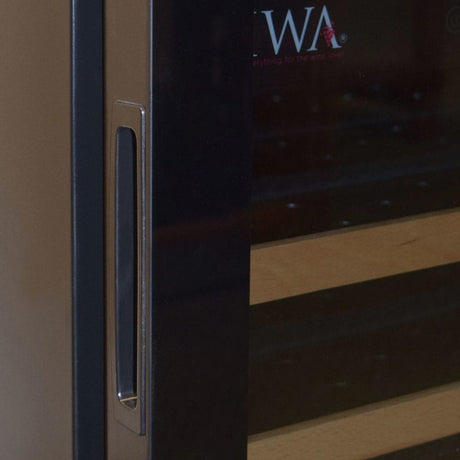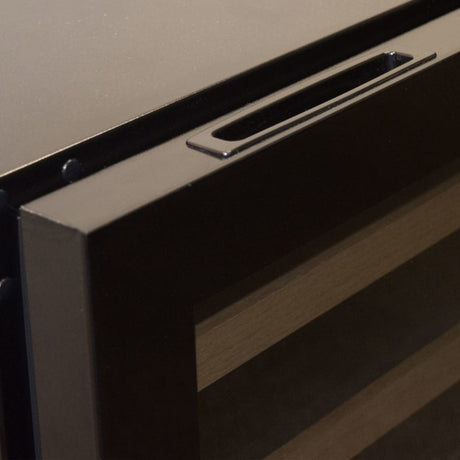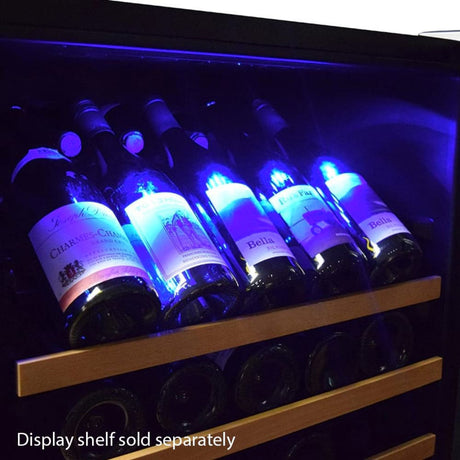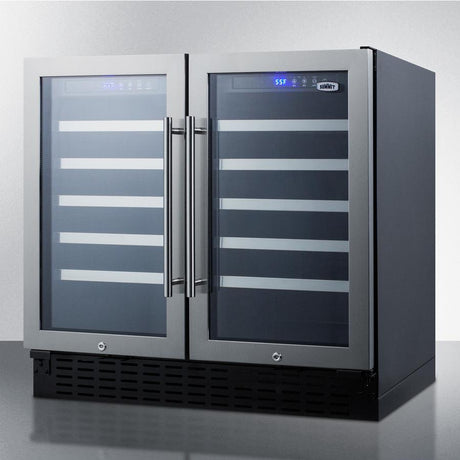Benefits
The beauty of a 100-bottle-capacity wine fridge is that it is large enough to stockpile a substantial wine collection yet small enough to fit into family kitchens.
You don’t need a wine cellar to use one. It is the perfect choice for wine connoisseurs and enthusiasts just starting with their first collection, and it comes with a long list of benefits:
Versatile:
100-bottle wine coolers, particularly those with adjustable shelving, are highly versatile.
You can use them to chill white wines, rose wines, and bubbly varieties such as prosecco and champagne, and you’ll always have a bottle at the ideal serving temperature.
Luxurious:
If you consider yourself a connoisseur, a wine fridge will help you store your coveted collection as they do in private vineyards and high-end restaurants.
They are undeniably luxurious, and popping a perfectly chilled bottle promises to have your friends in awe.
Wine Stays Fresh for Longer:
Wine is delicate and needs the correct conditions to maintain its integrity. A wine fridge will keep your collection at the ideal serving temperature while protecting it against UV light, fluctuating temperatures, and humidity.
Open bottles stay fresh longer in a wine refrigerator, so you will not need to throw them away.
Suitable for Red Wines, too:
With the recommended serving temperature of 62–68 degrees, red wines need chilling too, and if you live in a warmer state, a wine fridge is the perfect place to do it.
With a 100-bottle wine fridge, you’ll have plenty of space for your French Burgundies, Argentinean Malbecs, and Napa Valley Cabernets.
Aesthetically Pleasing:
Unlike traditional refrigerators, wine fridges are typically sleek, sophisticated, and styled to complement modern interiors. They are functional and aesthetically pleasing; you can install them in any room.
Substantial Storage Capacity:
A 100-bottle wine fridge is large enough for a private collection yet small enough to keep in family homes. With a wine cooler of this size, you can keep track of your inventory, organize your special reserves, and grab a chilled bottle whenever you need it.
Long-Term Investment:
A quality wine fridge should last 10, 15 or even 20 years, so they are a worthwhile investment for any wine connoisseur.
How To Choose
With more and more manufacturers offering 100-bottle wine refrigerators, choosing the perfect one for your collection can be overwhelming. Here are a few factors to consider when shopping for a wine fridge:
1. Dimensions:
100-bottle wine fridges come in various shapes and sizes, so you must measure your space to make sure it fits. Taller wine coolers work better in narrow spaces, but you may need an under-counter wine refrigerator to meet your storage needs.
2. Number of Temperature Zones:
While basic wine fridges have just one temperature zone, there are options with two or even three temperature-controlled compartments.
A single-zone model may be sufficient if you only drink white wines, but if you enjoy white, rose, and red wines, a multi-zone wine refrigerator could be a better option.
3. Thermoelectric or Compressor Cooling Technology:
Do you need a thermoelectric or compressor wine fridge? The former is quieter and more energy-efficient, and the latter is more suitable for cooling wines in warmer environments.
While domestic wine refrigerators typically use thermoelectric cooling technology, it is worth comparing your options if you live in a high-temperature state.
4. Humidity Control:
Does your wine fridge have humidity control? If not, it could damage your red wines or any bottle with a cork. Humidity control is essential when storing high-end wines, so your refrigerator should have an adjustable control for maintaining a humidity level of around 70 percent.
5. UV-Resistant Doors:
Most wines are sensitive to UV light, so look for a wine fridge with UV-resistant doors. Typically, wine refrigerators have glass doors, but not all are UV protected. If you have invested in high-quality wines, purchase a fridge with this additional feature.
6. Number of Shelves:
A high-quality wine fridge will have removable and height-adjustable shelves to accommodate all bottle sizes. While wooden shelves are more aesthetically pleasing, metal shelves work just as well, but don’t be tempted to save a few dollars on a wine fridge with fixed shelving. You may regret your purchase in the long run.
7. Noise Output:
Your wine fridge shouldn’t be any noisier than your kitchen fridge, but some high-capacity options, particularly those with compressor cooling technology, can generate more noise.
Check the noise rating of your wine refrigerator before you buy and look for a silent-operation fridge for kitchen or dining room installations.
8. Energy Efficiency:
Is your wine-cooling fridge energy efficient? Check the energy-efficiency rating as any other electrical appliance to reduce your carbon footprint and energy bills.
9. Locking Mechanism:
If you intend to store valuable reserves in your wine fridge, look for one with a built-in lock, it will not only provide an extra layer of security but also restrict access to your underage teens.
10. Budget:
How much do you want to spend on your wine fridge? Budget options start a just a few hundred dollars, while high-end models run to several thousand dollars.
Let your collection guide you. If you intend to use your wine refrigerator to store bottles costing over $100, it is worth investing in one with the latest technology.
Types
1. Single Temperature Zone Wine Coolers:
As the name suggests, single-zone wine refrigerators have just one temperature setting for the entire appliance. If you only drink one type of wine and do not need to store red wines at different temperatures to white and rose wines, this is the most economical option.
Single-zone wine fridges are available in freestanding or built-in designs, and as they are less expensive than the multi-zone options, they are a good starting point for those new to collecting wines.
2. Dual Temperature Zone Wine Fridges:
With a dual-zone wine refrigerator, you can create two different temperature-controlled zones in one fridge, making it ideal for red and white wine lovers.
You can create a cool zone of 50 – 55 degrees Fahrenheit for your Pinot Grigios, Chenin Blancs, and Rieslings and a warmer 62 – 68 degrees Fahrenheit zone to keep your Chianti, Merlot, and Pinot Noir wines at a perfect serving temperature.
While dual-zone wine fridges are slightly more expensive than single-zone alternatives, they are well worth the investment if you enjoy a varied collection of wines.
3. Built-In Wine Coolers:
If you want to integrate your 100-bottle wine fridge into existing cabinetry, shopping for a built-in wine cooler that will slot seamlessly into your pre-installed units makes sense.
They come in various shapes and sizes, and as built-in wine fridges have front ventilation, you can build them into any kitchen or entertainment room without worrying about overheating.
4. Freestanding Wine Coolers:
One of the many benefits of purchasing a freestanding wine fridge is that you can install it anywhere you have space (and a power socket) and easily relocate it. They are ideal for wine connoisseurs who regularly move apartments and perfect for those who frequently rearrange their living spaces.
Freestanding wine refrigerators are typically cheaper than the built-in alternatives, but as they have rear ventilation, they require adequate clearance on all sides.
If you place them too close to other units, this type of wine cooler can overheat, so install them with caution and check to make sure they have sufficient ventilation.
5. Wine Fridges with Thermoelectric Technology:
Thermoelectric wine fridges are energy-efficient, environmentally friendly, and quieter than the compressor-based options, so they are the ideal choice for wine enthusiasts living in apartment blocks or any other area where noise pollution is a concern.
While this type of wine cooler doesn’t perform as well in hot environments as compressor wine fridges, it is perfect for storing wine collections indoors.
6. Compressor Run Wine Fridges:
Compressor wine fridges run much like kitchen refrigerators, using a refrigerant (a coolant gas) to extract heat from the inside of the unit and a vapor compression refrigeration system to chill your wines to perfection.
Compressor wine fridges perform better in hot conditions than the thermoelectric alternatives, but they are louder, more expensive to run, and some models may produce vibration, which could damage mature red wines.
If you have a substantial collection of champagnes and white wines that require constant temperature control, a compressor-based wine cooler could be the best option, but you could see a spike in your energy bills.
Alternatives
You would need to drink lots of wine to benefit from a 100-bottle wine fridge. If not, one of the following alternatives might be a better option:
1. For a Restaurant or Bar:
You might think that a 100-bottle wine fridge is the standard size for a bar or restaurant, but if you have a high turnover, you’ll likely need something larger, and if you only sell a few glasses of wine a day, you may want something smaller.
You also need to consider space. Smaller restaurants may not have the room for a 100-bottle wine refrigerator, but thankfully, there are alternatives, as we explain below.
Alternatives: For smaller wine bars and intimate restaurants, a 50-bottle wine cooler could be sufficient. Alternatively, you could go for a wine and beverage center that allows you to store all types of drinks in one unit or a wine cooler with a dispenser for serving the perfect measure of chilled wine every time.
For larger premises, consider installing a wine cellar or purchasing a wine cave where you can store several hundred bottles of wine in a temperature-controlled environment.
2. For Your Home Collection:
A 100-bottle wine fridge is an investment for any wine enthusiast, but if you do not have sufficient space to store one, you might need to look for an alternative.
Alternatives: A smaller countertop wine cooler could be the perfect substitution, but an under-counter wine cooler might be a better choice if you prefer a built-in option. A 12-bottle wine fridge is better than no wine fridge, so start small and work your way up to a bigger option as your collection grows.
3. For Special Events:
Every entertainer needs a wine cooler, but if a 100-bottle wine fridge is too big for your entertainment area, you might need to look at the alternatives.
Alternatives: You could rent a wine cooler or fridge for the occasional special event, but if you entertain more often, it makes financial sense to buy one.
You could buy a small 12-bottle wine refrigerator, but if you only need to chill a few bottles each time, an old-fashioned ice bucket will serve just as well.
4. For Wine Retail Outlets & Tasting Rooms:
If you are a wine retailer or owner of a tasting room, you will likely need far more than 100 bottles in storage. Storing wines at the perfect temperature is essential when selling them to the public, so you will likely need a multi-zone wine fridge, or several single-zone units linked together.
Alternatives: If you are a professional wine retailer, investing in a custom-built wine cellar makes sense, where you can store hundreds of boxes at the ideal drinking temperature.
If your budget doesn’t stretch to that, a wine cave should be your second choice, followed by multiple wine fridges in a temperature-controlled room.
How to Install Your 100-Bottle Wine Fridge
Invest in a 100-bottle wine fridge, and you’ll never have to worry about warm wine again. But you need to install your wine cooler correctly and pay attention to the following potential challenges you might encounter:
1. Installation:
Wine fridges require a certain amount of floor space and are heavy when loaded to full capacity. Do you have room? Will you be able to open the door fully once installed?
Top Tip: Pick the perfect spot for your new wine cooler before it arrives and allow plenty of space to open the door, restock, and adjust the temperature. Place your wine fridge on a hard, level surface and close to a power socket.
2. Temperature Control:
The whole idea of a wine fridge is to store your wines at the perfect temperature and maintain their delicate flavor profile, but what is the perfect temperature?
Top Tip: While most wines thrive at 52 - 57°F, the optimal temperature varies, depending on the type of wine. Sparkling wines and champagne like it cold, between 42 and 45°F, while white wines prefer to bathe in temperatures of 46 - 54°F, light-bodied reds 56 - 61°F, and full-bodied reds 62 - 66°F.
3. Are You Prepared for Power Outages?
If you live in an area prone to power outages, you must have a back-up supply for your 100-bottle wine fridge. Regularly outages could damage your wines and the fridge and put your entire collection at risk.
Top Tip: Invest in a UPS (uninterrupted power supply) unit to power your wine fridge during outages. If your model is energy-efficient and outages are infrequent, a refrigerator backup battery should be enough to keep your wine fridge running for 2-3 hours.
However, if you reside in remote areas subjected to frequent power outages, you might need a gas-powered generator to keep your wine cooler running.
4. Don’t Forget About Humidity:
Many wine collectors focus on temperature control but need to remember humidity levels. If humidity levels are too low in your wine fridge, your corks could dry out. If they are too high, mold and mildew can occur.
Top Tip: Use a hygrometer to monitor the humidity level inside your wine fridge and aim for 60 – 70 percent humidity at all times.
5. Wine Fridge Cleaning & Maintenance:
Like your regular refrigerator, your wine fridge will require regular cleaning and maintenance to keep it running smoothly and maintain the quality of your wine collection.
Top Tip: Empty and clean your wine fridge every 3 – 6 months, check your ventilation system regularly for dust and debris, and test the temperature of your fridge’s cooling system to ensure it’s working as it should.
6. Organize Your Wine:
Not all wines are suitable for aging; the last thing you want to do is waste a good bottle. Organizing your wine fridge will make sure you keep track of your collection and know which wines to drink first.
Top Tip: Organize your wines by color, grape variety, or country (if you have an international collection), putting those that will age at the rear of your wine fridge and those that will not at the front.
It’s worth keeping a separate inventory of your stock and, where applicable, noting their ‘best before’ dates so you never waste a drop.
FAQs
How Many Bottles Can It Hold?
100-bottle wine fridges are designed to accommodate one hundred 750ml wine bottles. If it has adjustable shelves, you can store smaller Piccolo bottles and larger magnums, in which case, the total capacity of the fridge will change.
How Do Wine Fridges Work?
They work in the same way as kitchen refrigerators but use precision cooling technology to create the perfect storage temperature for wines. Some wine fridges have one temperature setting others have two or more.
Do All Wine Fridges Have Adjustable Shelves?
No. Some budget options have fixed shelves, but all high-quality wine refrigerators have removable, height-adjustable shelves.
Are Wine Fridges Energy-Efficient?
Again, this depends on the model you choose. Always check the energy efficiency of an appliance before you purchase and choose an environmentally-friendly wine fridge to save on your annual energy bills.
How Big Are 100-Bottle Wine Fridges?
Wine fridge dimensions vary by model. Check the specifications before you purchase. You need enough space to install it and fully open the door.
Are All Wine Fridges Suitable for Cabinet Installation?
No. You have freestanding wine fridges and built-in wine fridges. Only built-in options are suitable for cabinet installation as they have front ventilation rather than rear ventilation, like freestanding models.
Note: The above information is intended to provide a comprehensive overview of the benefits of a 100-bottle wine fridge and the considerations when choosing and installing one. Always refer to the manufacturer's guidelines and recommendations for specific models.







































